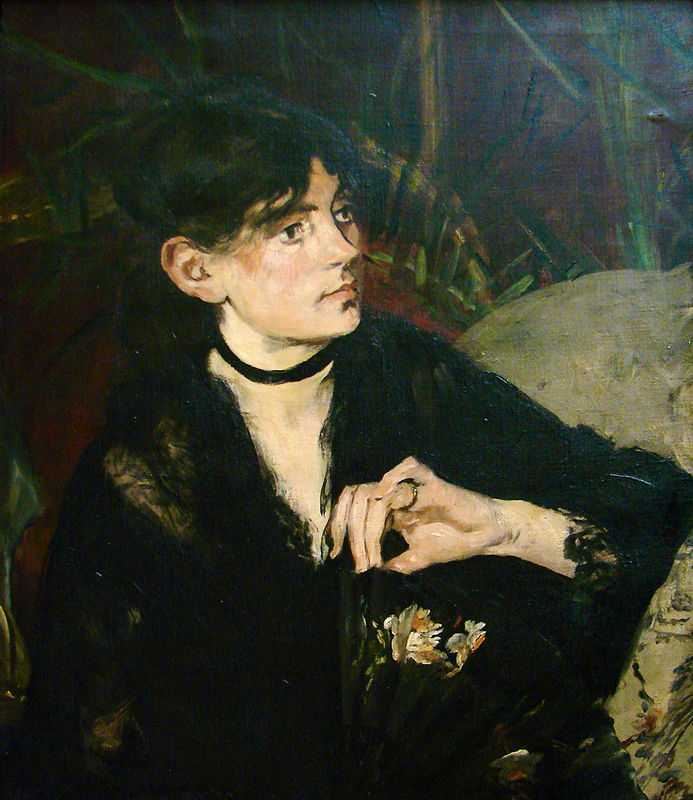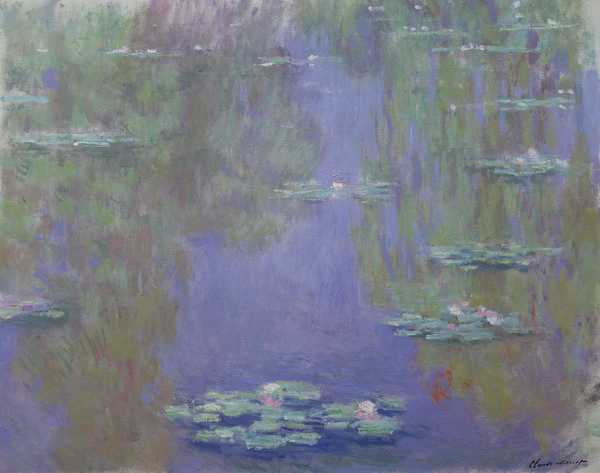1. The Cradle (1872)
Perhaps Morisot’s most famous painting, ‘The Cradle’ was painted in 1872.
It is one of Morisot’s first depictions of motherhood, for which she would later become known. This work features Morisot’s sister, Edma and her daughter, Blanche.
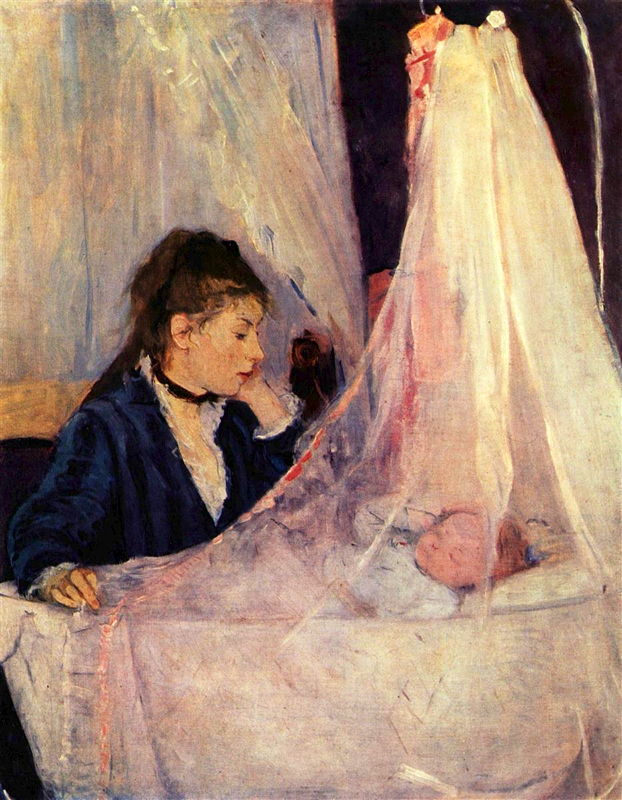
Light colours
What is most striking about this painting is the extremely light colour palette that Morisot used to paint the translucent net curtain which hangs over the cradle and the fabric draped in the background, as well as the pale skin tone of the seated woman.
Morisot contrasts these white hues with darker features, notably the woman’s dress, hair and the wall of the nursery. This colour contrast heightens the sense of calm and innocence portrayed by the sleeping baby who lies surrounded by white. The child’s angelic position is echoed by its mother who also sits with her arm raised.
A family affair
Like Morisot, Edma painted frequently as a child and both sisters received private painting lessons from tutors when they were growing up. However, with her marriage to a naval officer in 1864, Edma ceased painting entirely.
She assumed the role of wife and mother that was expected of middle-class women at this time and she did not return to painting. It was Morisot alone who continued with her ambitions of becoming an artist.
The first exhibition
This work was one of a collection shown at the 1874 Impressionist Exhibition. Morisot was the first woman to exhibit with the other Impressionist artists and she became a core member of the group.
When it was first displayed to the public, ‘The Cradle' did not receive much attention from critics, though some commented on the grace and elegance of the work. These were typical terms used to describe works of art created by women in the 19th century and Morisot’s so-called “feminine” work was consistently labelled with such terms.
As a consequence, her true artistic ability was not recognised until much later, long after her death.
2. Hanging the Laundry out to Dry (1875)
The image of laundry drying was a popular subject for Impressionist artists.
The bleached white of the fabric allowed the artists to play with light and shade and Edouard Manet, Claude Monet and Gustave Caillebotte all painted their own versions.
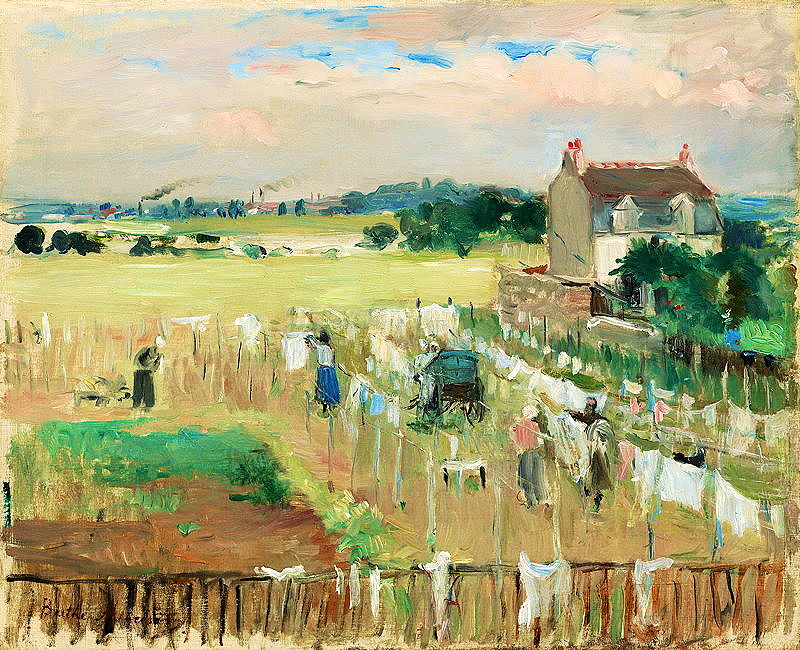
For Morisot’s painting, she chose a luminous scene with almost no shadow. She used thick, opaque impasto paint to create the light effects, building up hues of pink, blue and green.
Morisot's fence
In this painting, a fence that runs along the bottom of the work. This barrier gives a feeling that the viewer is excluded from the scene. The high perspective also has the same effect. Painting in 1875, Morisot would likely have positioned herself in an upper story window or on a balcony to get the best vantage point.
The Second Exhibition
She contributed ‘Hanging the Laundry out to Dry' to the Second Impressionist Exhibition of 1876. In his review of the exhibition, Alfred de Lostalot wrote that
“given her delicate colour and the adroitly daring play of her brush with light, it is a real pity to see this artist give up her work when it is barely sketched because she is so easily satisfied with it.”
This was a criticism regularly given to Morisot’s work which was seen by many as being unfinished. Like many Impressionist artists, the effects that Morisot was trying to achieve were entirely lost on many contemporary viewers.
Sold ...
Despite the criticism, the work was purchased by Dr Georges de Bellio, a Romanian collector who took an early interest in the Impressionist movement. It was passed by inheritance to his daughter, Victorian de Bellio and was next shown in 1929 in the Exposition d'oeuvres de Berthe Morisot at the Galerie Bernheim-Jeune in Paris.
3. In the Wheatfield (1875)
Set in the village of Gennevilliers close to Paris, Morisot painted ‘In the Wheatfield’ in 1875 whilst on holiday.
The Manet family had owned a property in the village since the early 1700s and Morisot regularly visited with her husband, Eugène Manet, in the spring and summer months.
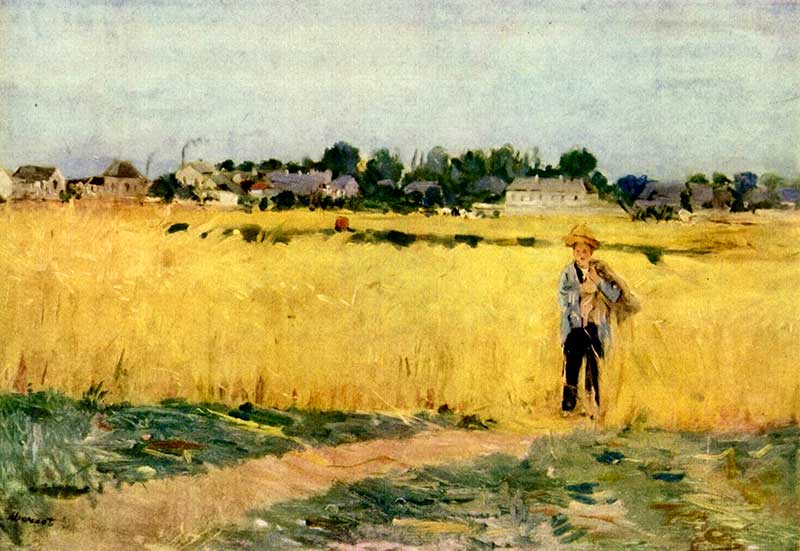
Gennevilliers
With the recent extension of the railway from Paris, Gennevilliers had become a popular location for Parisians looking to enjoy pastimes such as walks in the woods and boating on the Seine. For the wealthier middle classes, the area around Gennevilliers became a fashionable spot for weekend outings.
Morisot painted ‘In the Wheatfield’ en plein air on a bright but cloudy day. The wheatfield itself is made up of a dense mass of loose, quick brushstrokes in yellow tones. More detail is added to the buildings in the background where country cottages can be seen next to smoking chimney stacks.
Industrialisation
The presence of the chimneys means that this work is not simply a straightforward painting of an idyllic country scene. Instead, it is a portrait of modernity, depicting the ever encroaching march of industrialisation through the French countryside.
This theme can be seen in a number of works Morisot painted during 1875 at Gennevilliers. ‘Landscape at Gennevilliers’ is perhaps the most dramatic example where a large haystack is shown standing in a field surrounded by the smoking chimneys of newly-built factories in the background.
Morisot the Rebel
Morisot was the only woman Impressionist to paint regularly en plein air. This was particularly notable because during the 19th century, societal restrictions on women were becoming more pronounced.
There was a “consolidation of bourgeois society and its ideologies of femininity” and an ever increasing “identification of women with domesticity”. A consequence of these growing restrictions was that landscape painting, especially en plein air, became as prohibitive as studying nude painting.
The ‘Wheatfield’ can therefore be seen as a key painting in Morisot’s oeuvre that singles her out as an ambitious and fearless artist. In her landscape paintings, Morisot courted controversy to the same degree that Edouard Manet did with his Olympia and L’Dejuner Sur L’Herb.
Simply painting outside was a radical act for Morisot and her generation of woman artists.
4. Woman at her Toilette (c 1875)
Painted in pastel tones of lavender, pink, grey, blue, and white, ‘Woman at Her Toilette’ is a silvery painting that oozes femininity and refinement.
Pearls, satin, flower petals and a perfectly preened hairstyle add up to a scene that is both modern and classically elegant.
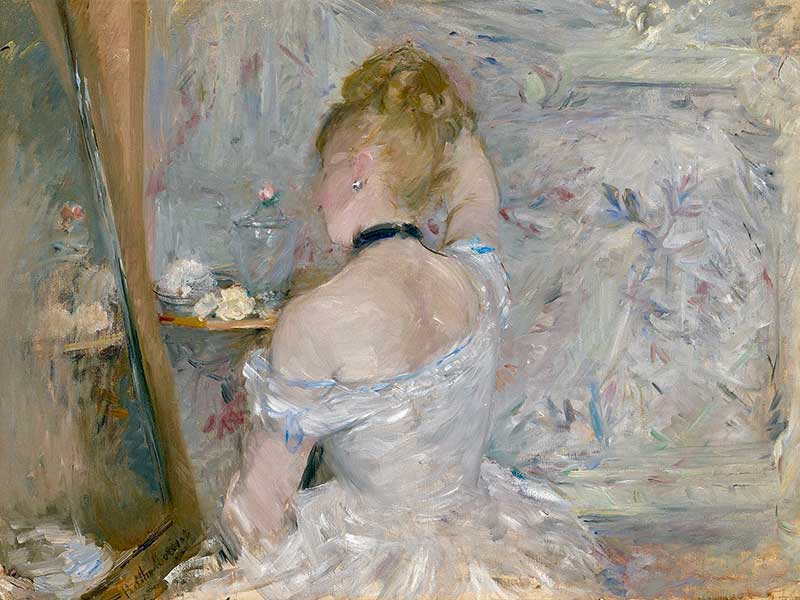
On the other hand, by painting a woman at her toilette Morisot was also subtly referencing the erotically charged works of male Impressionist artists including Edgar Degas, Renoir and Manet.
These artists frequently painted working-class women, usually prostitutes, in various stages of undress. Though Morisot’s painting does not contain the same overtly sexual subject matter, the viewer nevertheless observes the woman at the mirror with a closeness that suggests intimacy.
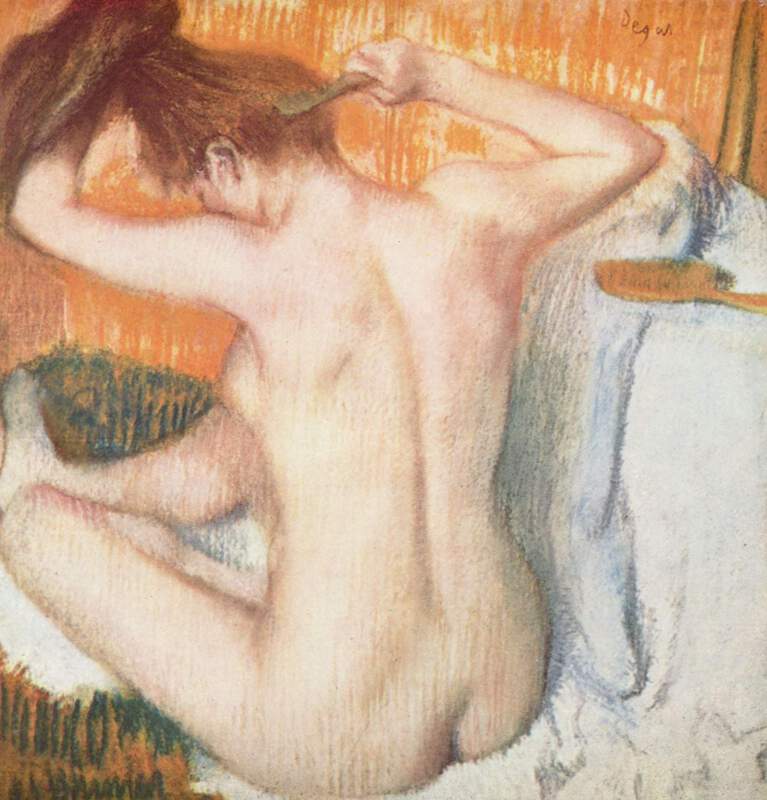
This nuanced eroticism makes this painting highly unusual as it was taboo for women artists to stray into such subject matter in the 19th century. Morisot is careful not to overstep societal boundaries - her figure is fully clothed and there are no other figures present - but in this piece she nonetheless experiments with a modern and potentially risqué subject.
5. The Pysche Mirror (1876)
Also known as ‘The Cheval-Glass’, ‘The Psyche Mirror’ from 1876 captures both an image of ordinary life and plays with the effects of light on a subject.
In the painting, a woman is seen holding the waist of her white blouse and looking at herself in the mirror in a room filled with intense light.
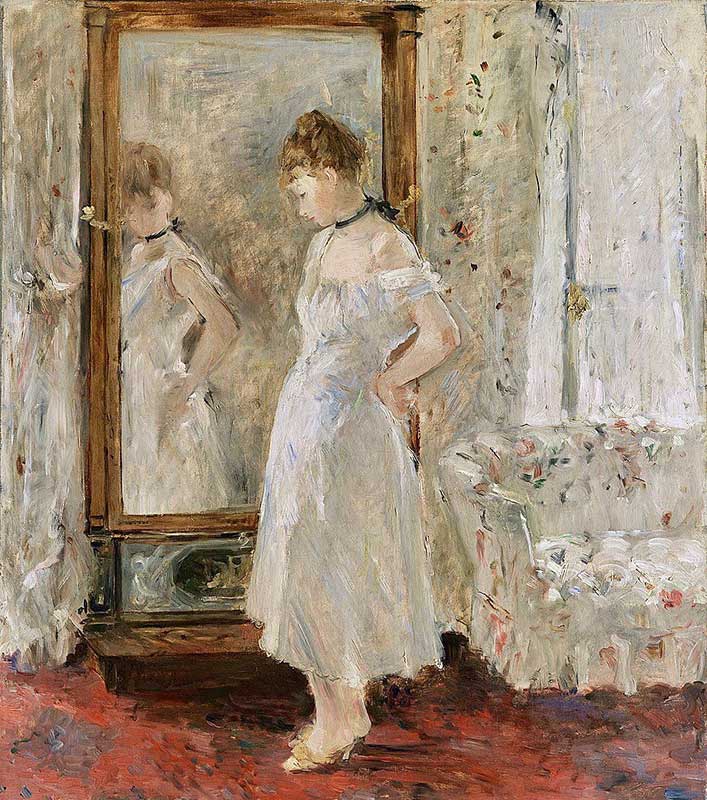
Introspection
Morisot’s work has often been cited for its ability to portray a rich internal world in the figures she painted. The women featured in her work often appear to be deep in thought.
At the same time, Tamar Garb has suggested that this painting
“relates to the old theme of Vanity, where Venus or another symbolic female figure is shown studying her own reflection.”
As well as being the French work for the full-length mirror the figure is looking in, ‘La Psyché’ was also the name of the woman loved by Eros.
Use of White
What is most striking about this work is Morisot’s use of white. The light that streams into the room from the two windows fills the space with white light which is further reflected in the mirror. The woman’s long white petticoat and pale skin further adds to this effect. The result is a rich range of white tones that spread across the whole scene, excluded only from the carpet and the wooden frame of the mirror itself.
6. Summer's Day (1879)
Art historians believe that this painting was originally exhibited under the title 'The Lake in the Bois de Boulogne’ at the Fifth Impressionist Exhibition of April 1880.
It was likely to have been hung with another painting titled ‘In the Bois de Boulogne’ which features two women who are wearing the same clothes as ‘Summer’s Day’. They may have been paid models or friends of Morisot.
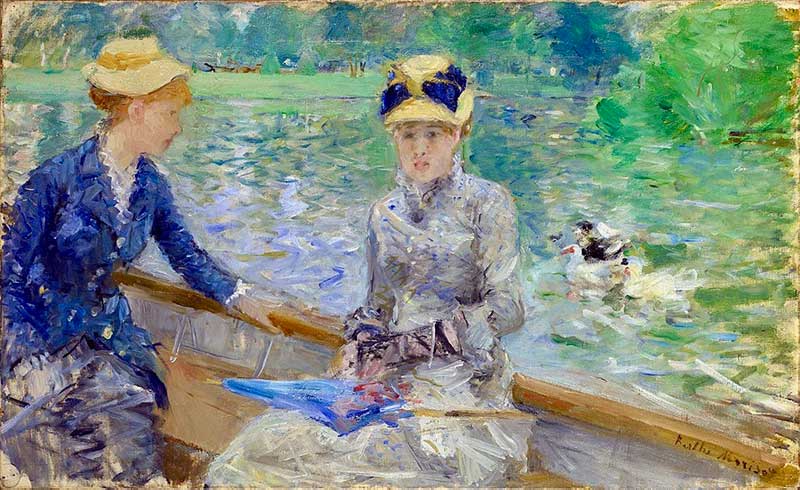
Morisot lived close to the Bois de Boulogne in the exclusive suburb of Passy. The Bois had been redesigned by landscape architect Adolphe Alphand during the 1850s under Napoleon III.
This makeover had transformed the park into a naturalistic space featuring woodland, winding paths, lakes and even islands. It became a highly fashionable location for recreational activities such as boating and cycling.
This scene perfectly represents the Impressionist theme of modern life and leisure activities, especially through a middle-class lens. At the same time, Morisot brings her characteristically dynamic style to the painting, executing the work with a boldness that contrasts with the relatively domestic scene.
Zig-zag brushstrokes create the sense of rippling and dappled light throughout the painting, echoing the water behind the figures. The scene is also tightly cropped, giving it an almost photographic feel, as though the viewer is seated in the boat.
7. Young Woman Knitting (1883)
One of a number of works Morisot painted depicting figures out-of-doors, ‘Young Woman Knitting’ has been dated to around 1883.
The work depicts a seated woman looking down at her hands with a piece of knitting resting on her lap. It is possible that this woman was Morisot’s daughter’s nanny. The brushstrokes are short and loose, giving the painting an impression of informality and impulsiveness.
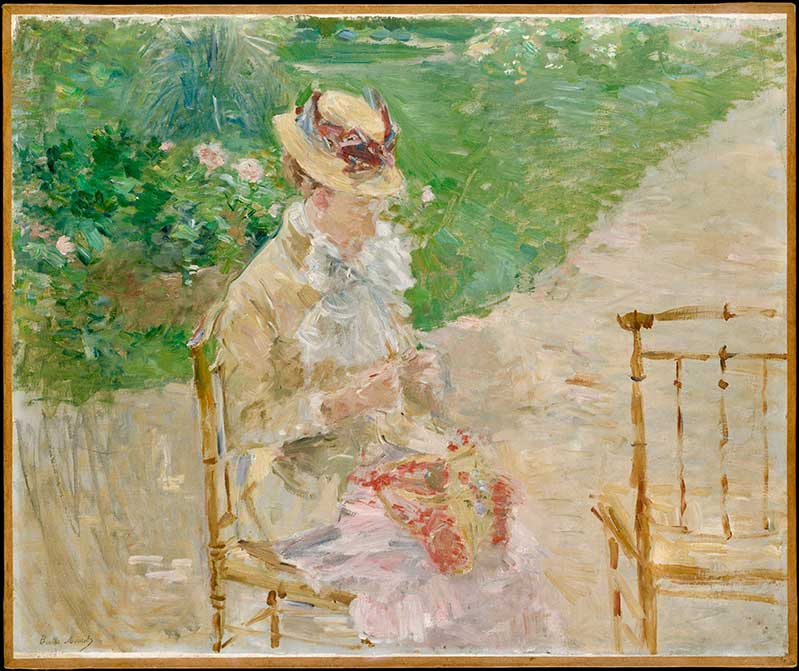
Morisot builds up the scene through light touches of colour to suggest form, leaving the figure’s face partially obscured and the knitting needles as just a suggestion. The light colour palette is characteristic of Morisot’s painting at this time. In the words of Colta Ives, “in her paintings she added white to nearly every colour in her palette to create pictures with a pearly radiance.”
The garden Morisot depicts in the work was likely her garden at Bougival. The gravel path and the roses behind the seated figure are typical of fashionable gardens in the 1880s. This was a period when gardens were becoming extremely popular, especially among wealthy urban Parisians.
Interestingly, there has been some confusion surrounding this painting. It has sometimes been mistaken for ‘A Woman and Child in a Garden’, also painted around the same period. This is likely due to the habit of collectors and dealers to change the names of paintings in catalogues.
8. Le jardin à Bougival (1884)
A truly beautiful painting, ‘Le jardin à Bougival’ from 1884 was inspired by Morisot’s garden in Bougival at 4 rue de la Princesse where she spent every summer between 1881 and 1884.
During her stay, Morisot painted over 40 canvasses in the garden, using her characteristically light, loose brushstrokes to portray the flowers and foliage.
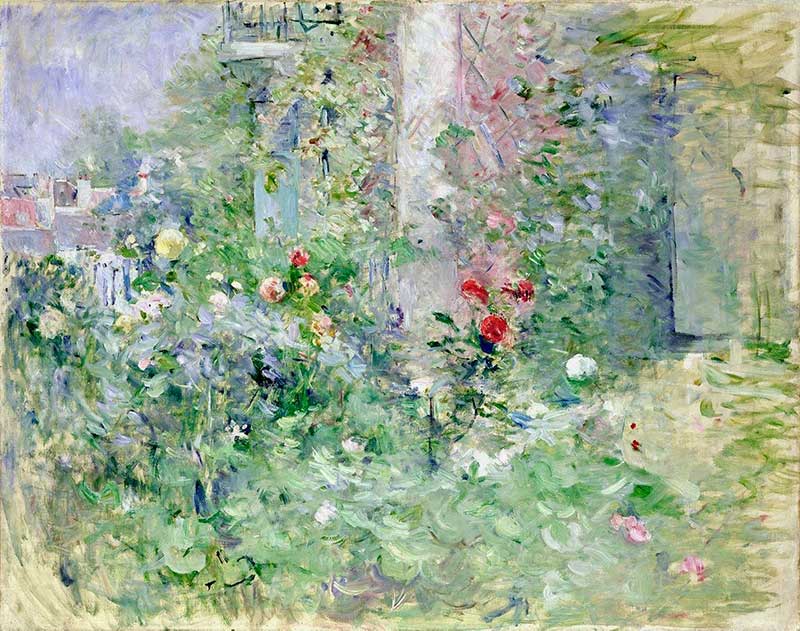
In this painting, Morisot captures the verdant growth in her garden, including several different coloured roses and the soft leaves and grasses that surround them. These are painted with gentle flicks and daubs.
The overall effect is a flurry of colour broken only by the wall of the house, a trellis and the garden gate. As art critic Charles Ephrussi described of Morisot’s work in 1880,
“she grinds flower petals onto her palette, in order to spread them later on her canvas with airy, witty touches.”
The whole canvas was most likely painted in just a few hours, giving the work a sense of immediacy and freedom. It has also been compared to the pastel works of Jean-Antoine Watteau and François Boucher’s Rococo paintings from the 18th century.
Similarly, Morisot may have drawn inspiration from Monet’s composition for ‘Villas at Bordighera’ painted the same year.
9. Reclining Shepherdess (1891)
‘Reclining Shepherdess’ is Morisot’s most complete nude painting, of which there are very few.
Nude painting was extremely uncommon among women artists at this time as they were not permitted to study the genre. This work is also unique among the Impressionists, though Morisot drew inspiration from Renoir the pose of her figure does not draw on any equivalent works.
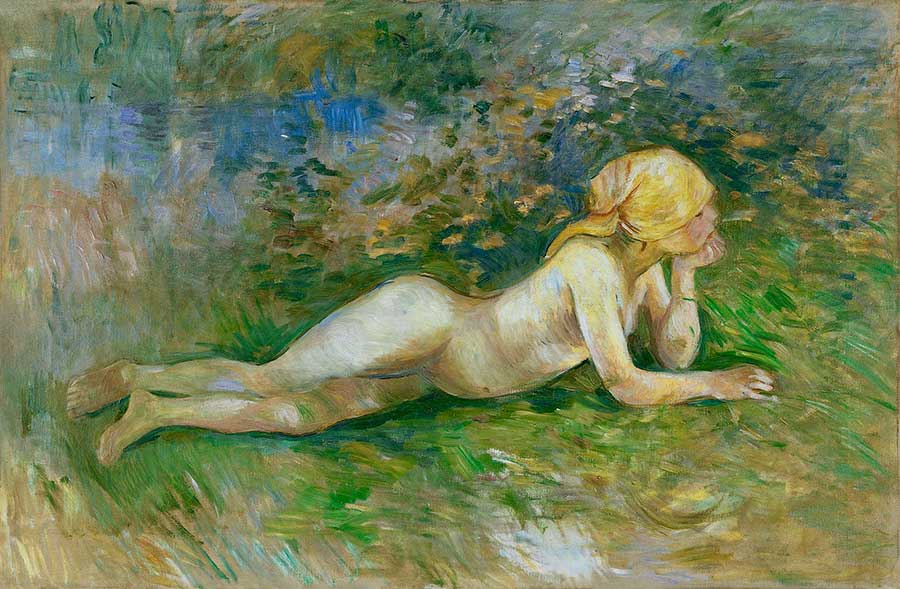
By the stage Reclining Shepherdess was painting, in 1891 (five years before Morisot's death), she was an accomplished and famous artist. This is probably one reason why she was sufficiently confident to push the boundaries of impressionism and societal acceptability.
For this painting, Morisot did several preliminary drawings of her model who was a girl from the village named Gabrièlle Dufous.
For the final piece, Morisot kept her brushstrokes more contained than her typical style from this period. She also excluded the sky or elements from the distant landscape to place the viewer’s focus on the figure alone.
The painting was executed in the garden of her house at Mézy-sur-Seine, near Meulan, situated around 50 kilometres west of Paris. In this space overlooking the Seine, Morisot painted a number of rustic paintings that sought to capture the rural feel of the Île-de-France region.
For this particular piece, Morisot may have drawn inspiration from Corot’s compositions from the 1860s featuring nudes in outdoor settings.
10. On the Terrace
Exhibited at the Third Impressionist Exhibition of 1877, ‘On the Terrace’ was painted the same year of the First Impressionist Exhibition in 1874.
This painting depicts a woman sitting on a terrace overlooking the coast.
Morisot painted ‘On the Terrace’ at the summer resort of Fécamp whilst she was staying with her Aunt. The same year she met her husband whilst the Manet’s were holidaying in the Normandy coastal town.
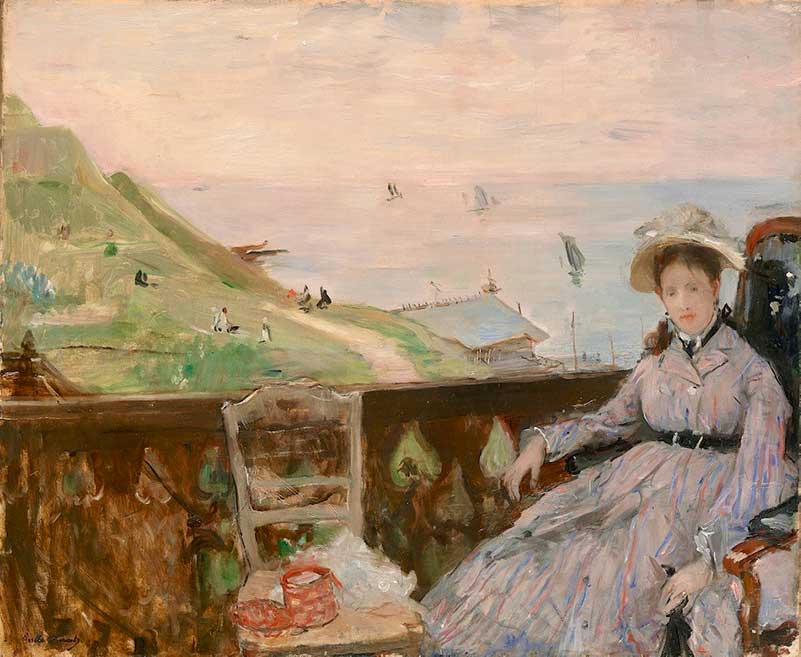
The former home of the Duke of Normandy, Fécamp was a popular location for wealthy Parisians to spend the summer months. The figure depicted in Morisot’s painting is Mme Boursier, the wife of Lucien Bouriser who was a nephew of Morisot’s father. This was one of several sketches and paintings Morisot made of Mme Bouriser during this period.
What is interesting about this work is the composition. The figure is off-centre, almost squashed into the corner of the canvas, giving the painting a cropped feel. The wall of the balcony compresses the figure even more, creating a dark barrier made up of thick brushstrokes. This physical barrier separates the woman from the space below and the wildness of the coast.
Griselda Pollock has cited this structure as a symbolic boundary between masculinity and femininity; the barrier between spaces open to women and those open to men. Barriers and boundaries are a common feature in Morisot’s work ranging from balustrades to fences to window frames. There is a sense of dislocation between the space of the women she depicts and the rest of the world. It is possible that this theme portrayed Morisot’s own experience as a woman and an Impressionist.


